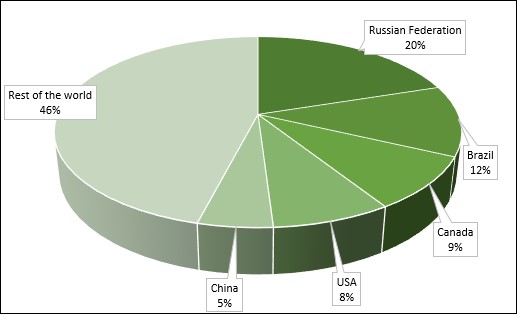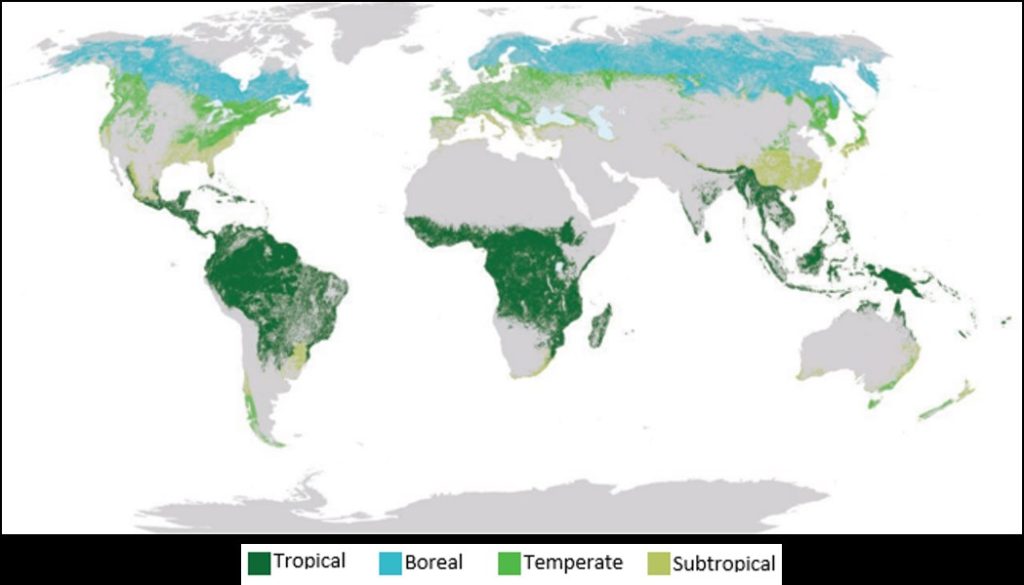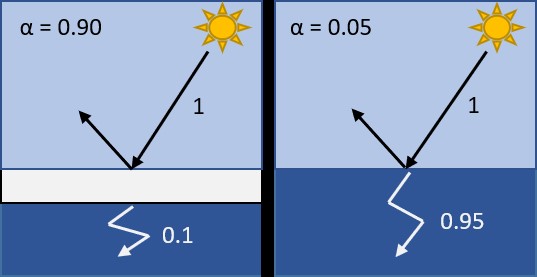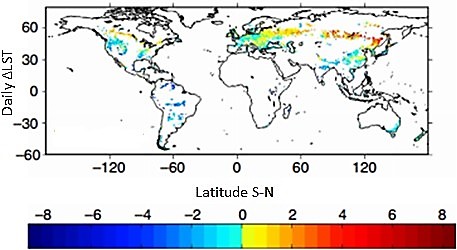Author

Abbreviations
BVOC | = | Biogenic Volatile Organic Compounds |
CCS | = | Carbon Capture and Storage |
ET | = | Evapotranspiration |
FAO | = | Food and Agriculture Organization |
GHG | = | Greenhouse Gas |
IPCC | = | Intergovernmental Panel on Climate Change |
LST | = | Land Surface Temperature |
LUC | = | Land Use Change |
SLCF | = | Short-Lived Climate Forcers |
SOA | = | Secondary Organic Aerosol |
Abstract
Forests cover an area equal to almost one third of total land area. Since 1990, 1.78 million km2 of forests have been lost worldwide. However, the rate of net forest loss has decreased over the past three decades. Forests store a significant quantity of carbon: as of 2020, the total forest C stock amounted to 662 Gt. As a consequence, they represent a potential instrument for climate change mitigation. Several factors need to be analysed when studying a forest’s effect on the climate; in particular, surface albedo, evapotranspiration, BVOC emissions and age of the vegetation. These parameters often have contrasting trends and can result in different impacts depending on the surrounding conditions, such as latitude. Local and global climate are affected differently by deforestation. Therefore, any forest management plans having climate change mitigation as a goal need to consider the effects of any proposed strategy on both.
1 Introduction
Forests cover an area of 40.6 million km2 worldwide, equivalent to almost one third of the total land area. Of this, 93% is represented by naturally regenerating forests, while the remaining 7% is planted. 45% of planted forest has been established mainly for the purposes of ecosystem restoration and soil and water protection, while the other 55% is more intensively managed and used for productive purposes. Different forest biomes account for different shares of the total forest-covered territory: 45% tropical, 27% boreal, 16% temperate and 11% subtropical. Forest distribution is not equal throughout the world: 54% of forest-covered land is located in the Russian Federation, Brazil, Canada, the US and China alone, as shown in Figure 1. Figure 2 shows the geographical location of the different forest biomes on a global level (FAO 2020).

Figure 1: Forest area coverage per country (adapted from FAO (2020))
According to FAO (the Food and Agriculture Organization of the United Nations), deforestation can be defined as the conversion of forest to different land uses (not necessarily due to human activity). Since 1990, 1.78 million km2 of forests have been lost globally. However, over the past three decades there has been a significant reduction in the rate of net forest loss, a parameter which takes into account both deforestation and forest expansion. When it comes to net forest area changes, there are contrasting trends in different regions of the world.

Figure 2: Forest area coverage per country (adapted from FAO (2020))
In both Africa and South America, forest loss has prevailed in the years since 1990. However, while in Africa the rate at which the net loss is taking place has increased in each of the decades between 1990 and 2020, in South America it has declined. Over the past decade, Asia, Europe and Oceania have experienced a net forest expansion instead. As a consequence of this and other land use change (LUC), the geographical distribution of forests is shifting. Overall, the net forest loss rate has decreased significantly since 1990, due to afforestation efforts and natural forest expansion, as well as a decline in deforestation. Moreover, there has been a decrease in the area covered by naturally regenerating forests, as well as an increase in the area of planted forests. Primary forests, where human activities are largely absent, currently occupy 11 million km2; however, this area is shrinking, though at a slowing pace. There are regional differences when it comes to forest management: less than 25% and 20% of forests in Africa and South America respectively have management plans, as opposed to the majority of those in Europe. However, managed forest areas are increasing across the globe (Scott et al. 2018, FAO 2020). Intense deforestation activities can be traced back to the Industrial Revolution, when forests were converted to crops and pastures to meet the increasing demand for agricultural land. Deforestation is still taking place, in particular in the tropics, as mentioned above; however, it is now partly offset by afforestation efforts (Scott et al. 2018).
Forests provide several goods and ecosystem services. They also store substantial amounts of carbon, playing a significant role in long-term carbon (C) sequestration (Zhou et al. 2015). The term carbon sequestration is used to describe any processes the result of which is to capture CO2 (or, more precisely, C) from the atmosphere and store it in a reservoir long-term (UNFCCC Glossary). As a consequence, forest ecosystems represent a potential for initiatives aimed at mitigating climate change by way of CCS (carbon capture and storage) processes. The achievement of this goal is considered crucial to the welfare of the planet, and it is being looked towards with increasing urgency, as the rate at which climate change has been occurring during the past 50 years is unprecedented in human history (Sferlazza et al. 2018, Bongaarts 2019). Forests worldwide have been estimated to contain 606 Gt of living above- and below-ground biomass and 59 Gt of dead wood. As of 2020, the global forest C stock amounted to 662 Gt, having decreased with respect to the 668 Gt of 1990. The forest carbon stock is contained in five different pools: the above-ground and below- ground biomass (living biomass), the deadwood and litter (dead biomass), and the soil (soil organic matter) (Sferlazza et al. 2018). The majority of carbon stored in forests is located in the organic matter in the soil (45%) and in the living biomass (44%). The remaining 11% can be found in litter and dead wood (FAO 2020). While forests have been widely recognised for their capacity to sequester a significant amount of C from the atmosphere, thus acting as a carbon sink, there remains uncertainty with regards to the future development and magnitude of this sink (Zhou et al. 2015). However, it has been estimated that they currently constitute a net carbon sink of around 1.1 Gt/yr, thus storing 45% of all terrestrial carbon (Liu et al. 2018). It has been assessed that a combination of efforts centred on avoided deforestation and forest restoration could provide up to 37% of the cost-effective CO2 mitigation necessary to meet the 2030 goals established in the Paris Climate Agreement. Namely, to limit the increase in the global average temperature to below 2 ◦C above pre-industrial levels (UNFCCC 2015, Griscom et al. 2017, Scott et al. 2018). The majority of the Intergovernmental Panel on Climate Change (IPCC) scenarios which project this threshold to be respected involve not only the reduction of anthropogenic greenhouse gas (GHG) emissions, but also the implementation of CO2 removal methods on a large scale. In this context, the role of forests in storing carbon is particularly relevant. Moreover, proper forest management would allow not only to potentially increase the forest C sink, but also to simultaneously reduce emissions derived from land use activities (Griscom et al. 2017). There is a difference in the amount of carbon stored in different biomes: 55%, 32% and 14% of carbon is stored in tropical, boreal and temperate forests respectively. The role forests can play in climate change mitigation is only guaranteed if the carbon stored in living biomass exceeds the amount lost due to dying biomass as well as forest fires and harvesting activities. Mediterranean forests are currently considered particularly vulnerable from this perspective (Sferlazza et al. 2018).
This article aims at analysing the contrasting effects of factors pertaining to forest-covered land on the climate and trying to assess the impact of deforestation.
2 Discussion
Over the last decade, efforts have been made to reduce deforestation and increase afforestation. However, deforestation remains an important topic of discussion, particularly when considering the ongoing net forest loss in both Africa and South America (Li et al. 2015, FAO 2020). The ability of forest ecosystems to act as carbon sinks makes them appear as useful contributors to climate change mitigation efforts. However, the correlation between forest land use and climate benefits is not straightforward. Indeed, the impact of deforestation of the climate is dependent on a complex series of biogeochemical and biogeophysical factors, their strength and interactions. Biogeochemical effects, such as changes in carbon sinks, can impact the carbon dioxide exchange with the atmosphere by way of an altered tree cover. Vegetation can also affect the emission of biogenic volatile organic compounds (BVOCs), which in turn leads to the formation of short-lived climate forcers (SLCFs), such as ozone and methane, which have themselves an impact on the climate. The most complicated factors to account of for are the biogeophysical ones, such as albedo and evapotranspiration (ET). The reason behind their complexity is their heterogeneity from a spatial perspective; depending on the context, biogeophysical factors can have a warming or cooling effect on the climate, thus either enhancing or diminishing the carbon sequestration role of a forest. (Li et al. 2015, Scott et al. 2017, 2018).
Before proceeding with this analysis, it is necessary to briefly explain some of the terminology used in this article. The albedo of the Earth is the fraction of the incoming solar energy which is scattered back into space by the planet (Stephens et al. 2015). Its relevance in climate change studies is due mainly, though not exclusively, to the ice-albedo feedback: ice is a more reflective surface than both land and water. Temperature increases lead to the ice melting; the newly uncovered surfaces absorb a larger fraction of the incoming solar radiation, thus leading to further warming, which in turn causes more ice to melt, creating a cycle (Rose et al. 2017, Choi et al. 2020). Figure 3 shows a simplified model of the albedo effect. SLCFs are substances characterised by a shorter lifetime in the atmosphere with respect to CO2 (Fu et al. 2020). Evapotranspiration is the loss of water from the soil through both evaporation from the soil surface itself and transpiration from the leaves of the vegetation growing on this soil (Britannica Academic 2021)

Figure 3: Albedo effect in an ice-covered (left) and water-covered (right) area (adapted from Choi et al. (2020))
Forest areas generally have a darker colour than cropland or grass and therefore reflect a smaller fraction of light. When deforestation occurs, however, this fraction increases, leading to a higher albedo and therefore a cooling effect (Scott et al. 2018). At the same time, deforestation practices cause the release into the atmosphere of a portion of the carbon previously stored in the forest, thus reducing its carbon stock and creating a warming effect. Indeed, deforestation frequently provokes direct emissions of carbon dioxide into the atmosphere, by way of forest burning or wood decays: and an increase in the atmospheric concentration of CO2 leads to a raise in temperature. Tropical deforestation alone is behind about 10% of the total anthropogenic carbon emissions (Bebber & Butt 2017, Scott et al. 2018).
Forest vegetation also emits BVOCs at a rate that can be affected by LUC: BVOCs in the atmosphere are oxidised by ozone and the hydroxyl and nitrate radicals. As a result, the oxidative capacity of the atmosphere is impacted, and that in turn affects the concentration of ozone and methane, which are both greenhouse gases. Moreover, BVOCs can interact with nitrogen oxides, leading to the formation of ozone into the troposphere (Monks et al. 2015, Scott et al. 2018). The new particles derived from the oxidation of BVOCs can interact with each other and other atmospheric particles, leading to the formation of other, larger particles (secondary organic aerosol, SOA). Once they achieve a size of 100 nm, they are able to participate in direct interactions with the incoming shortwave solar radiation, acting as condensation nuclei and leading to the formation of cloud droplets, which can in turn affect the climate (Scott et al. 2018). Clouds can produce a cooling or a warming effect, depending on several factors, the most important being altitude: higher clouds have a tendency to trap heat, while lower clouds reflect a larger fraction of the incoming solar radiation. As such, the effects of clouds are behind large uncertainties in climate models (Brown 2016, Klein et al. 2017). It has been estimated that a decrease in BVOCs due to LUC has in the past led to reduced CH4 and O3 concentrations, thus resulting in a cooling effect (Scott et al. 2018). As mentioned above, another factor to take into consideration when it comes to forest management is evapotranspiration. ET is dependent on the geographical area: dry climates tend to favour smaller ET variations, thus increasing the likelihood of cooling, while wet climates have the opposite effect (Li et al. 2016).
Another factor to take into account is forest age, as it has a significant impact on the ecosystem’s ability to act as a carbon sink. It has been observed that the vegetation C sink initially undergoes a rapid increase with forest age, followed by a decrease after a little more than 20 years. The soil C sink, on the other hand, continues to increase with age; to be more precise, soil acts as a source for the first 20 years and as a sink after that. As living biomass and soil are the two largest C pools in forests, both of these trends have an important impact on the climate. The net carbon accumulation in a forest ecosystem depends heavily on forest age, particularly in the long-term. Therefore this parameter should be analysed in depth when planning for forest management with climate change mitigation purposes. As elevated tree age tends to reduce the amount of carbon the trees themselves can assimilate, a possible approach in terms of forest management would be to replace low-productivity forests (reforestation), using the wood thus obtained as a substitute for fossil fuels. It has been found that after about 50 years, the sink capacity of a forest is significantly diminished, thus making this proposed strategy particularly appealing. However, it does not take into account carbon sequestration in the soil, which, as mentioned, follows a different trend (Zhou et al. 2015). Greater benefits might be derived by forest management strategies based on data collected about the specific context to which they should be applied.
As mentioned above, it is difficult to analyse the effects that biogeophysical factors in forests have on the climate, particularly on a local level. Part of the problem stems from the difficulty in modelling such factors accurately. Indeed, even though the biophysical effects of forests are predominant on the local scale, thus making them especially relevant when establishing forest management practices, there are significant difficulties when trying to use climate models on such a scale. This is due to their lack of resolution and of detailed information covering the appropriate areas, as well as uncertainties in the parametrization of the physical processes involved. It is possible to use regional climate models to achieve the desired resolution, but it is not currently feasible to use these data to model global climate, due to computational limitations (Li et al. 2015). It is therefore extremely difficult to draw any accurate conclusions when it comes to merging local and global forest climate information into a cohesive picture.
While it is not easy to analyse the effects forests have on the climate on a local level, some conclusions have been drawn. According to Li et al. (2015), boreal forests cause a strong warming in winter and a moderate cooling during the summer, thus having a net yearly warming effect. Temperate forests lead to a moderate warming in winter and a moderate cooling in summer, with a net yearly cooling effect. Finally, tropical forests, which cover the largest area, appear to have a strong cooling effect throughout the year. These results are collected in Table 1. Overall, biophysical factors have been shown to have a warming effect in the tropics and a cooling effect in the other regions (Li et al. 2016). To analyse the impact of a forest area on the climate, it is possible to use land surface temperature (LST) as a parameter, by calculating the difference between the value of the forest minus that of open land (∆LST); positive results indicate that a warming is taking place, while negative values indicate a cooling (Li et al. 2015). Figure 4 shows the average daily variation in LST in forest areas across the globe.
The tropics are an area of particular interest in terms of LUC-related climate change mitigation efforts: they guarantee a cooling effect all throughout the year, but they are also the area where the forest loss rate is highest. Protected areas have been established in tropical regions, in order to attempt to preserve ecosystem biodiversity and limit deforestation. This action has led to a reduction in C emissions related to deforestation by 29% in the period between 2000 and 2012, thus showcasing how important forest ecosystems are when it comes to climate change mitigation efforts (Bebber & Butt 2017).
Table 1: Climate impacts of different forest biomes throughout the year (data obtained from Li et al. (2015)).
Winter | Summer | Net annual effect | |
Boreal forests | Strong warming | Moderate cooling | Warming |
Temperate forests | Moderate warming | Moderate cooling | Cooling |
Tropical forests | Strong cooling | Strong Cooling | Cooling |

Figure 4: Average daily LST variation in forests worldwide (Li et al. 2015)
Deforestation itself has contrasting regional impacts, as it is leading to a cooling in boreal and temperate regions and to a warming in tropical regions. As mentioned above, this is due in part to increased albedo and in part to decreased evapotranspiration. These two processes, which have competing impacts on the temperature, are at least partially dependent on latitude (Li et al. 2016). As an example, deforestation in areas which are seasonally covered in snow might lead to a further cooling effect, as snow is more reflective than land and significantly more reflective than a forest. Indeed, the net effect of both biogeochemical and biogeophysical factor on the climate has a strong correlation to the latitude of the forest (Scott et al. 2018). Latitudinal temperature variation depends on the conditions under which deforestation takes place and it is influenced to a smaller degree by the magnitude of each individual biophysical change (Li et al. 2016). This shows the relevance of local climate when attempting to assess the effect forest, and therefore deforestation, might have on the global climate.
Regardless of all the uncertainties related to the impact of forest ecosystems on climate change, it is generally accepted that, on a global scale, deforestation is likely to contribute to global warming, while largely intact forest ecosystems can play a substantial role in climate mitigation efforts aimed at reducing the concentration of anthropogenically emitted CO2 (Zhou et al. 2015, Scott et al. 2018). However, it remains necessary to separate tropical forests from boreal and temperate ones to obtain reliable results in any analysis centering on this topic. Moreover, when establishing forest management plans and policies, it is important to focus on the local climate and impacts on any LUC activities, without however neglecting global impacts.
3 Conclusions
Forest ecosystems can store significant amounts of carbon, thus acting as a carbon sink. This effect is reduced by the decline in forest-covered land, and therefore by deforestation. However, the relationship between forest ecosystems and climate is not entirely straightforward and several factors need to be considered.
Forests (and as a consequence deforestation) affect the climate though several biogeochemical and biogeophysical factors. Namely, surface albedo, evapotranspiration and BVOC emission. Furthermore, the age of the vegetation has an impact on the carbon sink capacity of a forest and therefore needs to be taken into consideration when deciding on a management plan which aims at contributing to climate change mitigation efforts.
Local and global climate are impacted differently by deforestation. On a global scale, the predominant effect is warming; however, that is not necessarily the case in all regions of the world. It is therefore necessary for any comprehensive climate mitigation strategy to take into account both local and global effects. The process, however, is rather complex, due to difficulties in climate modelling as well as the often-contrasting trends of the factors to be considered.
References
Bebber, D. P. & Butt, N. (2017), ‘Tropical protected areas reduced deforestation carbon emissions by one third from 2000–2012’, Scientific reports 7(1), 1–7.
Bongaarts, J. (2019), ‘Ipbes, 2019. summary for policymakers of the global assessment report on biodiversity and ecosystem services of the intergovernmental sciencepolicy platform on biodiversity and ecosystem services’, Population and Development Review 45(3), 680–681.
Britannica Academic. Evapotranspiration 2021. Retrieved 1 January 2021, from https://academic.eb.com/levels/collegiate/article/evapotranspiration/472296
Brown, A. (2016), ‘Decadal cloud dynamics’, Nature Climate Change 6(12), 1060–1060.
Choi, Y.-S., Hwang, J., Ok, J., Park, D.-S. R., Su, H., Jiang, J. H., Huang, L. & Limpasuvan, T. (2020), ‘Effect of arctic clouds on the ice-albedo feedback in midsummer’, International Journal of Climatology.
FAO. 2020. Global Forest Resources Assessment 2020 – Key findings. Rome. https://doi.org/10.4060/ca8753en
Fu, B., Gasser, T., Li, B., Tao, S., Ciais, P., Piao, S., Balkanski, Y., Li, W., Yin, T., Han, L. et al. (2020), ‘Short-lived climate forcers have long-term climate impacts via the carbon–climate feedback’, Nature Climate Change 10(9), 851–855.
Griscom, B. W., Adams, J., Ellis, P. W., Houghton, R. A., Lomax, G., Miteva, D. A., Schlesinger, W. H., Shoch, D., Siikam¨aki, J. V., Smith, P. et al. (2017), ‘Natural climate solutions’, Proceedings of the National Academy of Sciences 114(44), 11645–11650.
Klein, S. A., Hall, A., Norris, J. R. & Pincus, R. (2017), Low-cloud feedbacks from cloud- controlling factors: a review, in ‘Shallow Clouds, Water Vapor, Circulation, and Climate Sensitivity’, Springer, pp. 135–157.
Li, Y., Noblet-Ducoudr´e, D., Nathalie, D., Davin, E. L., Motesharrei, S., Zeng, N., Li, S. & Kalnay, E. K. (2016), ‘The role of spatial scale and background climate in the latitudinal temperature response to deforestation’, Earth System Dynamics 7(1), 167–181.
Li, Y., Zhao, M., Motesharrei, S., Mu, Q., Kalnay, E. & Li, S. (2015), ‘Local cooling and warming effects of forests based on satellite observations’, Nature communications 6(1), 1– 8.
Liu, X., Trogisch, S., He, J.-S., Niklaus, P. A., Bruelheide, H., Tang, Z., Erfmeier, A., Scherer-Lorenzen, M., Pietsch, K. A., Yang, B., Khn, P., Scholten, T., Huang, Y., Wang, C., Staab, M., Leppert, K. N., Wirth, C., Schmid, B. & Ma, K. (2018), ‘Tree species richness increases ecosystem carbon storage in subtropical forests’, Proceedings. Biological sciences 285(1885).
Monks, P. S., Archibald, A., Colette, A., Cooper, O., Coyle, M., Derwent, R., Fowler, D., Granier, C., Law, K. S., Mills, G. et al. (2015), ‘Tropospheric ozone and its precursors from the urban to the global scale from air quality to short-lived climate forcer’.
Rose, B. E., Cronin, T. W. & Bitz, C. M. (2017), ‘Ice caps and ice belts: The effects of obliquity on ice- albedo feedback’, The Astrophysical Journal 846(1), 28.
Scott, C. E., Monks, S. A., Spracklen, D., Arnold, S., Forster, P., Rap, A., A¨ ija¨l¨a, M., Artaxo, P., Carslaw, K., Chipperfield, M. et al. (2018), ‘Impact on short-lived climate forcers increases projected warming due to deforestation’, Nature Communications 9(1), 1–9.
Scott, C., Monks, S., Spracklen, D., Arnold, S., Forster, P., Rap, A., Carslaw, K., Chip- perfield, M., Reddington, C. & Wilson, C. (2017), ‘Impact on short-lived climate forcers (slcfs) from a realistic land-use change scenario via changes in biogenic emissions’, Faraday Discussions 200, 101–120.
Sferlazza, S., Maetzke, F. G., Iovino, M., Baiamonte, G., Palmeri, V. & La Mela Veca, D. S. (2018), ‘Effects of traditional forest management on carbon storage in a mediterranean holm oak (quercus ilex l.) coppice’, Iforest-Biogeosciences and Forestry 11(2), 344.
Stephens, G. L., O’Brien, D., Webster, P. J., Pilewski, P., Kato, S. & Li, J.-l. (2015), ‘The albedo of earth’, Reviews of geophysics 53(1), 141–163.
UNFCCC, ‘Glossary of climate change acronyms and terms’, https://unfccc.int/process-and-meetings/the-convention/glossary-of-climate-change-acronyms-and-terms}}, accessed: 01.01.2021
UNFCCC, ‘United nations framework convention on climate change (2015) cop 21 climate agreement (UNFCCC,Paris)’.
Zhou, T., Shi, P., Jia, G., Dai, Y., Zhao, X., Shangguan, W., Du, L., Wu, H. & Luo, Y. (2015), ‘Age-dependent forest carbon sink: Estimation via inverse modeling’, Journal of Geophysical Research: Biogeosciences 120(12), 2473–2492.